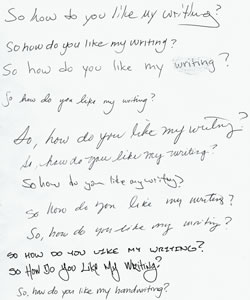The Death of Handwriting
Thanks to computers, e-mail and texting, most Americans have crummy handwriting, and some experts are advocating that schools stop teaching kids to write
By Brandon Bosworth
E-mail this story | Print this page | Archive | RSS

|
If this article were handwritten, you wouldn’t be reading it. Or, to be more to the point, you wouldn’t be able to.
Like a growing number of modern Americans, my penmanship is abysmal, a messy collection of warped lines and imperfect circles thrown together so haphazardly as to only occasionally resemble actual words. Chances are your own scribble is probably no better, perhaps even worse. It’s a sad state of affairs when mature adults are unable to communicate with each other with such rudimentary tools as pen and paper.
It was not always this way. A generation or two ago things were quite different. Just spend some time watching a few old movies and pay attention whenever the camera zooms in on a note or letter. Even the gangsters in B-grade crime dramas from the 1930s write in such a way as to put a modern Harvard-educated CEO to shame. Or consider my grandmother. A very proper Southern lady, she comes from a time in which the handwritten note was the rule, not the exception. To this day, I cannot conceive of sending her a typed letter. Instead I force myself to write my correspondence to her by hand, taking the time and care to at least approach legibility. While the process requires more effort than banging out something on the keyboard, something tells me it is worth it - and not only out of consideration to my grandmother. Writing by hand is a more personal expression than typing will ever be.

|
And as we were reminded during the Olympics, handwriting is one of the great inventions of the Chinese.
Not all would agree. Anne Trubek, an English professor at Oberlin College , recently wrote a provocative piece for Good magazine titled “Stop Teaching Handwriting.”
She claims “handwriting is a historical blip in the long history of writing technologies, and it’s time to consign to the trash heap this artificial way of making letters, along with clay tablets, smoke signals, and other arcane technologies.”
Trubek prefers a more high-tech approach, putting so much faith in keyboards and voice-recognition software that one can’t help but wonder if her rant would have been better suited for the pages of the technogeek bible Wired.
While the idea of not teaching handwriting will surely strike some readers as a rather radical notion, Trubek is in some ways behind the curve. Already kids are making it through the educational system with little or no instruction in penmanship. A hundred years ago, penmanship was considered a basic required skill in schools, hence its place as one of the “Three Rs.” By the 1960s, 30 percent of American elementary schools had no formal handwriting program. According to Newsweek, back then the Zaner-Bloser Co. - a major publisher of penman-ship curriculums - recommended setting aside 45 minutes a day to teach children cursive writing. By the 1980s, they were suggesting 15 minutes.

|
Nowadays, kids are lucky to get 10 minutes. They are also lucky if they happen to have a teacher who actually knows how to teach handwriting. A study by Vanderbilt University professor Steve Graham found that only 12 percent of teachers have ever taken a course on how to teach penmanship.
Our cousins across the pond are no better. In the supposedly more genteel, cultured United Kingdom, the BBC reports one in three children struggle with handwriting, and nearly one in five usually write in text message language. Forty percent of British boys and 25 percent of British girls age 11 cannot meet national writing standards.
Kids who don’t learn to write well grow up to be adults who don’t write well. Reed Hayes is a court qualified handwriting and document examiner in Honolulu. With more than 30 years’ experience, he has had a chance to see how the average American’s handwriting has changed over the years.
“In the last 20 years especially,” he observes, “there has been a decline in penmanship. Handwriting isn’t as fluid, isn’t as rhythmic ... it’s uncoordinated and poorly arranged on the page.”

|
He, too, notes, “Handwriting is not being taught as it once was.” Not only are children not being taught the value of good penmanship, in some cases they aren’t taught cursive writing at all. “In some schools they learn to print and that’s it.”
The obvious question arises: If you don’t know cursive, how do you sign your name? Hayes says often kids just sort of make up their signatures, but also points out “as a forensic document examiner, I’m seeing more and more printed signatures.”
There is something strangely mind-boggling about the very concept of a printed signature. Would we still say “put your John Hancock here” if he had printed his name on the Declaration of Independence? Come to think of it, can you imagine if the Declaration had been composed all in print? It would look as if it had been written by angry but verbose children instead of by some of the greatest minds of a generation.
Luckily, here in Hawaii, kids are still learning the basics of penmanship, including cursive writing. “Children are taught handwriting at the early stage of their education,” says the Department of Education’s Daniel Hamada, “They learn it in preschool, kindergarten and first grade.”
According to Hamada, who is the assistant superintendent in the DOE of Curriculum, Instruction and Student Support, there is no statewide, organized handwriting program, giving teachers leeway in how to teach the skill. In general, the familiar pad-and-pencil methods are still used. For some of us, the image of the old “Big Chief” writing tablet may come to mind.
“The covers may have changed,” says Hamada, “but the dotted lines are still there.” More detailed workbooks, complete with exercises, are available for students
Page 1 of 2 pages for this story 1 2 >
E-mail this story | Print this page | Comments (0) | Archive | RSS
Most Recent Comment(s):








